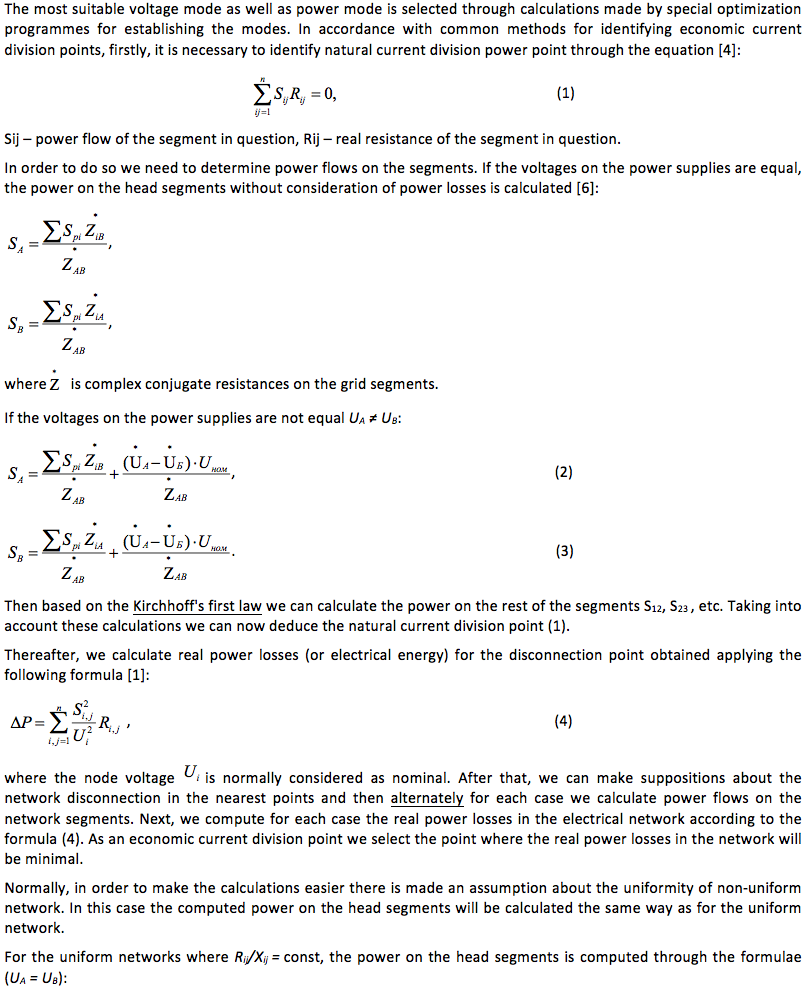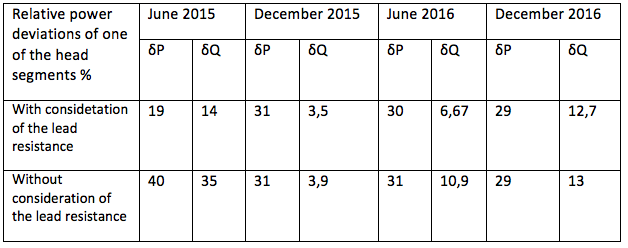

Vol. 38 (Nº 52) Year 2017. Page 38
Vera SIDOROVA 1; Viktor KARCHIN 2; Urey EGOSHIN 3
Received: 09/10/2017 • Approved: 21/10/2017
ABSTRACT: This paper offers an improved method to identify the point of disconnection in non-uniform complex meshed networks with voltage 110 and 220 kV. Using the example of several electrical networks, we calculated the power rates on certain electrical network segments with and without consideration of real and reactive resistance on these network segments. The obtained figures were subsequently compared with actual power data provided through planned annual observations by one of the network companies. According to the results obtained, we can deduce that when calculating the power on electrical network without taking into account the resistance, it might result in considerable deviations of figures on real as well as reactive power. Therefore, when identifying the economical current division point in non-uniform networks it is necessary to take into consideration real and reactive resistance on the segments. |
RESUMEN: Este artículo ofrece un método mejorado para identificar el punto de desconexión en redes de malla complejas no uniformes con tensión de 110 y 220 kV. Usando el ejemplo de varias redes eléctricas, calculamos las tasas de energía en ciertos segmentos de red eléctrica con y sin consideración de resistencia real y reactiva en estos segmentos de red. Las cifras obtenidas se compararon posteriormente con los datos reales de potencia proporcionados a través de observaciones anuales planificadas por una de las empresas de la red. De acuerdo con los resultados obtenidos, podemos deducir que al calcular la potencia en la red eléctrica sin tener en cuenta la resistencia, podría provocar desviaciones considerables de las cifras en potencia real y reactiva. Por lo tanto, al identificar el punto de división de corriente económica en redes no uniformes, es necesario tener en cuenta la resistencia real y reactiva en los segmentos. |
Almost all electrical networks are non-uniform owning to the disparity between reactive and real resistances on the network segments. In comparison with uniform electrical networks where the ratio is Xij / Rij = const, given the disparity between natural and economic power distribution current, non-uniform networks present additional power losses [1].
Conventionally, we can consider that there is an equalizing current with correspondent equalizing power that flows in non-uniform meshed network, which is caused by inhomogeneity of the network and therefore leads to the additional real power losses [2]. The reduction of the impact of inhomogeneity presupposes the reduction in inhomogeneity of network parameters or reaching the balance in equalizing powers [3].
One of the ways of reducing inhomogeneity impact is to disconnect the circuit where equalizing current flows. The network circuit disconnection is the most common measure that companies put into practice in order to reduce losses by reducing the impact of electrical network inhomogeneity. The issue here consists in identifying the network disconnection point where real power losses will be minimal. As for non-uniform electrical networks, here the economic current division point (the mode of minimal losses in real power) does not coincide with natural current division point [4]. Hence, the task becomes quite troublesome. In practice it is most common to select such point randomly which results in considerable losses in real power. For more efficient transmission of electrical energy it is essential to analyse regularly the power flows in these networks so as to identify the most optimal current division points [5].


For this study we have chosen the typical existent non-uniform double-ended electrical networks 110 and 220 kV that belong to a network company with different voltages on head segments. Calculations of power on the segments were made according to the data obtained from planned measurements carried out during winter and summer periods in 2015 and 2016. The power flows on the segments were calculated in accordance with equalizing power using the formulas (2) and (3), and charge capacity [2]. Then following the commonly recognised methodology, based on the Kirchhoff's first law, we identified power flows on the rest of the segments. Using the formula (1) we determined the natural current division point as well as computed the real power losses in the whole network following the formula (4). Once we obtained power figures on the head segments, these were compared with actual power figures obtained during planned measurements. The results of relative deviations of real (δP) and reactive (δQ) powers of one of the studied electrical networks are illustrated in the table below.
A similar computation of power on the head segments was made, but without consideration of figures on lead resistance depending on the brand, i.e. with the help of formulas (5) and (6). The results of relative deviations of the figures obtained are illustrated in percent in the table below.
From the information summarized in the table we can conclude that there is a possibility of significant deviations of results owning to the assumption about uniformity of non-uniform electrical network. Because of such assumption there is a high probability for incorrect identification of economic current division point.
Similarly, in this paper we determined the economical current division point for summer and winter periods in the studied electrical networks. In the given electrical network the economical current division point for summer and winter periods happened to be the same. For 2015 and 2016 the economic current division points did not coincide. Hence, for the efficient energy savings the constant analysis of its location is needed. There are also other authors who emphasize on the importance of the constant analysis of modes in non-uniform networks 10 kV [7]. The effectiveness of such measures is demonstrated by the existence of modern devices which provide quite precise results, automatic measuring equipment on the substations, telemechanics, and usage of AIIS KUE (automated measuring and information system for electric power fiscal accounting, electric power fiscal metering system).
Table. Relative deviations from the real figures of figures on power in head segments.

The obtained results show that omitting the resistance in network segments when calculating the power in non-uniform electrical network may result in significant deviations of real as well as reactive powers. Thus, when calculating modes in non-uniform electrical networks it is essential to consider both real and reactive resistances on the network segments.
Lykin, A.V. (2013). Energy saving and energy efficiency in electric networks. Novosibirsk, Novosibirsk State Technical University.
Gerasimenko, A.A. & Fedin, V.T. (2008). Transmission and raspredelnie eletkricheksoy energy. Ed. 2nd, Rostov n/D.: Phoenix.
Zhelezko, Y.S. (2009). Electricity losses. Reactive power. Power Quality: Guidelines for practical calculations. Moscow: ENAS.
Shvedov, G.V., Sipacheva, O.V., ed (2013). Electricity losses during transportation on electric networks: the calculation, analysis, regulation and reduction: a manual for schools. Moscow: MEI.
Azarov, V.S. (2005). Transmission and distribution of electricity in the examples and solutions. Moscow: MGOU.
Lychev, P.V. & Fedin, V.T. (1997). Electrical systems and networks. Solving practical problems. Minsk: publ DizaynPRO.
Sidorova, V.T. & Karchin, V.V. (2016). Redistribution of flows the power in complicated a closed networks of 10 kV overhead to reduce losses and improve power quality. Proceedings of the universities: Problems of power, 11-12, 51.
1. Mari State University, Yoshkar-Ola, Russian Federation; E-mail: veranig@yandex.ru
2. Mari State University, Yoshkar-Ola, Russian Federation; E-mail: veranig@yandex.ru
3. PJSC "Interregional Distribution Grid Company of the Center and Privolzhje "Branch "Marienergo", Yoshkar-Ola, Russia; E-mail: Egoshin_YY@energy.mari.ru